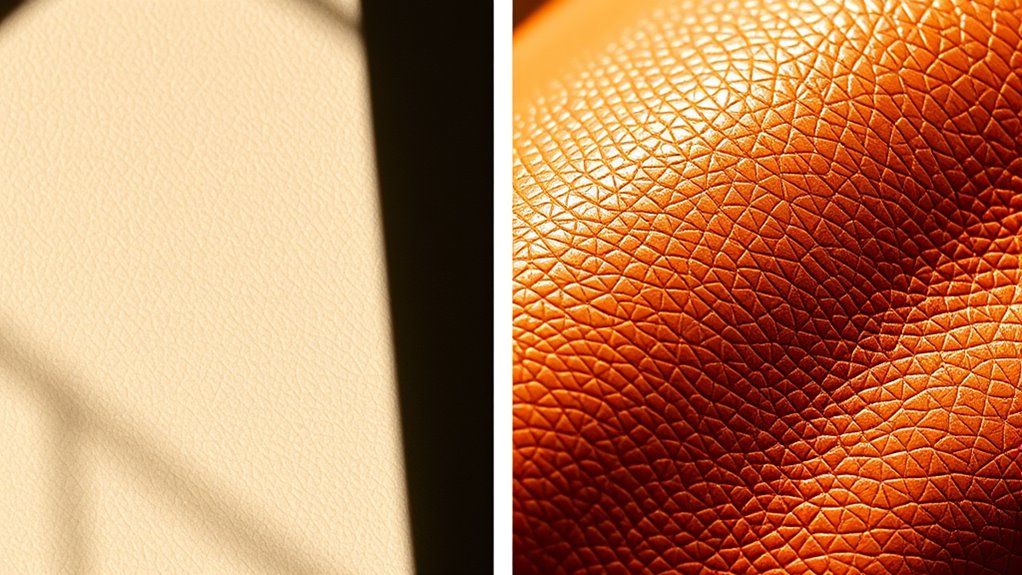Vegan leather is a more sustainable choice since it often has a lower environmental impact, using less water, land, and energy, while avoiding animal cruelty. Although traditional animal leather offers durability and a genuine look, some vegan options are advancing in quality and style, making them increasingly comparable. If you want to discover how these materials stack up in performance and eco-friendliness, there’s more to explore just ahead.
Key Takeaways
- Vegan leather generally has a lower environmental impact, using fewer resources and producing fewer pollutants than animal leather.
- Advances in vegan leather materials have improved durability, making performance comparable to traditional leather.
- Animal leather production involves significant water, land, and carbon emissions, whereas vegan options are more sustainable.
- Proper care can extend vegan leather’s lifespan, but some synthetic types may be prone to cracking or fading over time.
- Ethical considerations favor vegan leather, as it avoids animal cruelty while providing stylish, eco-friendly alternatives.

Have you ever wondered how vegan leather compares to traditional animal leather? It’s a common question as more people seek sustainable alternatives without sacrificing style. When evaluating vegan leather, one of the biggest factors to consider is its environmental impact. Unlike animal leather, which requires raising and processing animals—a process that consumes significant water, land, and energy—vegan leather is made from synthetic materials or plant-based sources. These options typically result in a lower carbon footprint and reduce the demand for animal agriculture, which is a major contributor to greenhouse gas emissions. Additionally, manufacturing vegan leather generally produces fewer pollutants, and since it doesn’t involve animal slaughter, it sidesteps ethical concerns related to animal cruelty. This shift toward vegan alternatives is driven by a desire to lessen environmental damage while still enjoying durable, fashionable accessories.
Furthermore, ongoing innovations in sustainable materials continue to enhance the quality and eco-friendliness of vegan leather, making it an increasingly viable option for consumers. Aesthetic appeal plays a crucial role in your decision-making process, too. Many worry that vegan leather may look or feel inferior compared to traditional leather, but that’s increasingly not the case. Modern vegan leathers have advanced significantly, offering textures and finishes that mimic genuine leather quite convincingly. You’ll find a variety of styles, colors, and grains, allowing you to choose pieces that match your personal taste. For those who prioritize appearance, vegan leather can be just as stylish and luxurious as animal leather, often with a more uniform look that’s difficult to achieve with natural hides. The surface of vegan leather can be polished, embossed, or textured to replicate the aesthetic appeal of traditional leather, making it suitable for high-end fashion or everyday accessories. Plus, because vegan leather can be produced in a controlled environment, it often results in fewer imperfections, giving your items a clean, consistent look.
While vegan leather offers notable advantages in environmental impact and aesthetic appeal, it’s essential to consider durability and care. Some synthetic versions may not age as gracefully, and certain types can be prone to cracking or fading over time. However, advancements in materials and finishing techniques are continually improving longevity, giving you options that balance sustainability with performance. Ultimately, choosing vegan leather allows you to reduce your ecological footprint without sacrificing style or quality. It’s a compelling alternative that aligns with a more conscious lifestyle, providing you with fashionable, eco-friendly options that look just as good as traditional leather—sometimes even better.
Frequently Asked Questions
How Does Vegan Leather Compare in Durability Over Time?
Vegan leather generally offers good durability, but it may not last as long as animal leather due to differences in material longevity. You might notice more wear and tear over time, especially with frequent use. However, high-quality vegan options can withstand daily wear, and proper care extends their lifespan. Keep in mind, the durability varies depending on the material type, so choose wisely based on how much wear and tear you expect.
Are There Health Concerns With Vegan Leather Manufacturing?
Think of vegan leather manufacturing like baking a cake—ingredients matter. You might worry about chemical safety, as some vegan leathers contain adhesives or dyes that could cause allergy risks or skin irritation. While many brands prioritize safer, non-toxic materials, it’s essential to check labels. Overall, health concerns are generally lower than animal leather, but always stay informed about the specific chemicals used in production.
Can Vegan Leather Be Recycled or Reused Effectively?
Yes, vegan leather can be recycled and reused effectively. Recycling processes for vegan leather often involve breaking down the material to create new products, reducing waste. Its reuse potential depends on the type of vegan leather and the manufacturing methods used. You can extend its lifespan by repurposing or refurbishing, making it a more sustainable choice. Proper recycling and reuse help minimize environmental impact and maximize the material’s value.
How Does Vegan Leather’s Cost Compare Long-Term?
You’ll find that vegan leather’s price comparison is often more affordable over time, especially since it tends to cost less upfront and requires less maintenance. While animal leather may last longer, vegan options are typically more budget-friendly and can be replaced easily. This makes vegan leather a practical choice if you’re considering affordability over time, as it balances initial costs with ongoing savings and versatility.
What Are the Environmental Impacts of Animal Leather Production?
Animal leather production causes significant environmental pollution through chemical runoff from tanneries, which harms waterways and ecosystems. It also leads to resource depletion, requiring large amounts of water, land, and energy. By choosing animal leather, you contribute to these issues, while vegan leather has a lower environmental footprint. Being aware helps you make more eco-friendly choices, reducing your impact on the planet and supporting sustainable practices.
Conclusion
Now that you’ve explored both vegan and animal leather, it’s clear that choosing eco-friendly options can feel like wielding a superpower for the planet. Vegan leather offers a sustainable, cruelty-free alternative that doesn’t compromise on style or durability—so you can feel good about your choices. Remember, every time you pick vegan leather, you’re making a bold move to protect our world from the brink of environmental chaos. Your decision truly can change everything!









